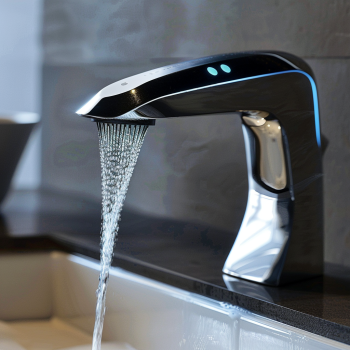

Auto flow sensor taps, also known as touchless faucets, are innovative devices designed to provide convenience, hygiene, and water conservation in various settings such as public restrooms, kitchens, and healthcare facilities. In this article, we'll delve into the intricate workings of these taps, exploring their components, working principle, benefits, installation process, and more.

Auto flow sensor tap utilizes advanced technology to detect the presence of hands or objects beneath the faucet and automatically dispense water. This touchless operation not only reduces the spread of germs and bacteria but also promotes water efficiency by eliminating unnecessary wastage.
The heart of an auto flow sensor tap is the electronic sensor, typically located at the base or near the spout. This sensor employs infrared technology to detect motion or presence within its vicinity.
Connected to the electronic sensor is the solenoid valve, which controls the flow of water. When the sensor detects movement, it sends a signal to the solenoid valve, prompting it to open and allow water to flow. Once the movement ceases, the valve closes, halting the flow of water.
Auto flow sensor taps are powered by either batteries or electricity. Battery-operated taps offer flexibility in installation but require periodic battery replacements. In contrast, electrically powered taps are typically connected to a power source and do not rely on batteries.
When a user approaches an auto flow sensor tap, the electronic sensor detects their presence and activates the solenoid valve. This allows water to flow through the faucet, enabling the user to wash their hands without touching any handles or knobs. Once the user moves away, the sensor detects the absence of motion and shuts off the water flow, conserving water and reducing wastage.
· Hygiene: Touchless operation minimizes the spread of germs and bacteria, promoting better hygiene.
· Water Conservation: By automatically turning off when not in use, auto flow sensor taps help conserve water, reducing utility costs and environmental impact.
· Convenience: Users can easily access water without the need to touch potentially contaminated surfaces, enhancing convenience and user experience.
Installing an auto flow sensor tap typically involves mounting the faucet to the sink or countertop and connecting it to the water supply lines. Depending on the model, electrical wiring or battery installation may be required. It's essential to follow the manufacturer's instructions carefully to ensure proper installation and functionality.
To maintain optimal performance, regular cleaning and inspection of auto flow sensor taps are necessary. Cleaning the sensor and removing any debris or mineral buildup can help prevent malfunctions and ensure reliable operation. Additionally, checking and replacing batteries or power sources as needed is essential for uninterrupted functionality.
Despite their efficiency, auto flow sensor taps may encounter issues such as sensor malfunctions, leaks, or low water pressure. Troubleshooting steps may include adjusting sensor sensitivity, checking for obstructions in the water supply lines, or replacing worn-out components. Consulting the manufacturer's guidelines or seeking professional assistance can help resolve these issues effectively.
Compared to traditional taps with manual handles or knobs, auto flow sensor taps offer several advantages. They provide touchless operation, promoting hygiene and reducing the spread of germs. Additionally, they help conserve water by automatically shutting off when not in use, contributing to sustainability efforts and cost savings.
Auto flow sensor taps find widespread applications in various settings, including:
· Public restrooms
· Commercial kitchens
· Healthcare facilities
· Food service establishments
· Residential bathrooms
Their versatility and benefits make them an ideal choice for environments where hygiene, convenience, and water conservation are paramount.
The adoption of auto flow sensor taps contributes to environmental sustainability by conserving water resources. By reducing water wastage and promoting efficient usage, these taps help minimize the ecological footprint associated with traditional water fixtures.
As technology continues to evolve, we can expect further advancements in auto flow sensor tap design and functionality. Innovations such as improved sensor accuracy, enhanced water-saving features, and integration with smart home systems are likely to shape the future of touchless faucet technology.
Auto flow sensor taps represent a significant advancement in plumbing technology, offering touchless operation, enhanced hygiene, and water conservation benefits. By understanding their components, working principle, and installation requirements, users can harness the full potential of these innovative fixtures to create more efficient and sustainable environments.
Are auto flow sensor taps suitable for residential use?
· Yes, auto flow sensor taps are increasingly popular in residential settings, offering convenience and hygiene benefits.
Can auto flow sensor taps be retrofitted to existing sinks?
· In many cases, yes. There are retrofit kits available that allow users to upgrade their existing taps with auto flow sensor technology.
Do auto flow sensor taps require regular maintenance?
· Like any plumbing fixture, auto flow sensor taps benefit from regular cleaning and inspection to ensure optimal performance.
Are auto flow sensor taps more expensive than traditional taps?
· While initial costs may be higher, the long-term benefits of water savings and hygiene make auto flow sensor taps a worthwhile investment.
Can auto flow sensor taps be adjusted for water temperature?
· Some models offer temperature control options, allowing users to adjust the water temperature to their preference.
Do you have questions or comments about any of our bathroom hardware & slow close toilet seat? We want to hear from you.
Suite 2206, No. 888 North Sichuan Road, Shanghai, 200080, China